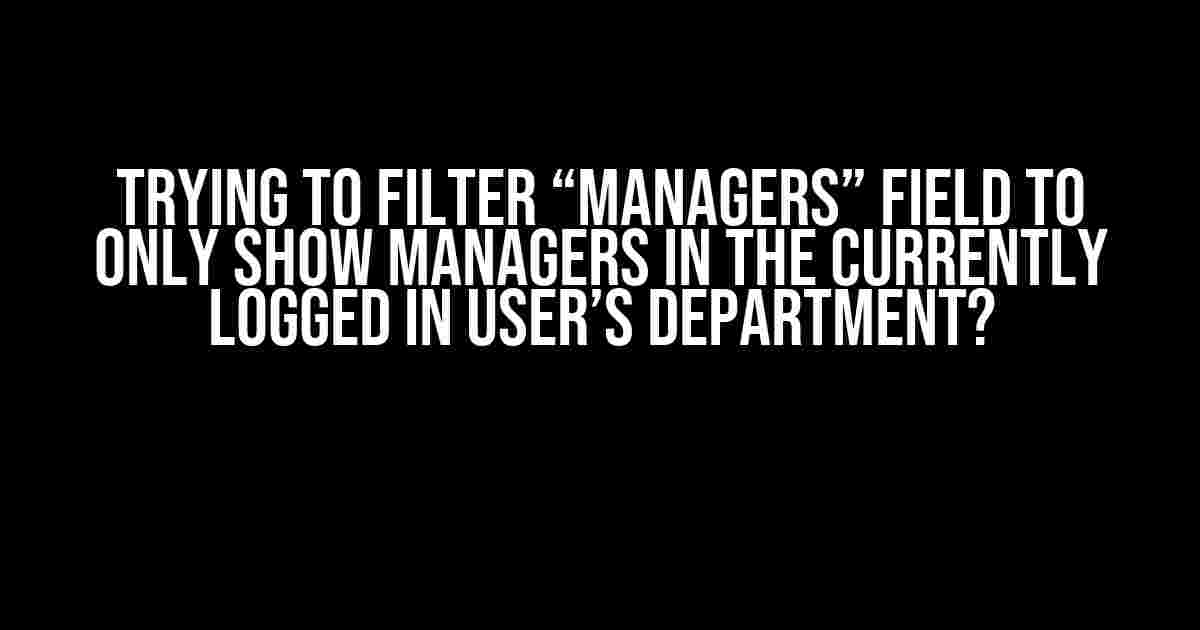If you’re struggling to filter the “managers” field to only show managers in the currently logged in user’s department, you’re not alone! This seemingly simple task can be a real challenge, especially if you’re not familiar with the intricacies of filtering and department hierarchy. Fear not, dear reader, for we’re about to dive into the world of filtering and department-based logic.
Understanding the Requirements
Before we begin, let’s break down the requirements:
- Show only managers in the currently logged in user’s department
- Filter the “managers” field to achieve this
- We’re assuming a standard department hierarchy with managers and team members
The Challenges of Filtering
Filtering can be a complex beast, especially when it comes to dealing with department hierarchies. You might be thinking, “Why can’t I just use a simple filter like `department = current_userdepartment`?” Well, it’s not that simple. What if a manager is part of multiple departments? What if a team member is reporting to a manager in a different department?
These are just a few of the gotchas you’ll encounter when trying to filter the “managers” field. But don’t worry, we’ll tackle these challenges head-on!
Step 1: Identify the Current User’s Department
The first step in our journey is to identify the current user’s department. This is crucial in determining which managers to show in the filtered list. You can achieve this using a simple formula:
current_department = {{ user.department }}Assuming you’re using a standard {{ user }} object with a `department` property, this formula will retrieve the current user’s department.
Step 2: Create a Department Hierarchy
Next, we need to create a department hierarchy to determine the managers in the current user’s department. You can use a nested array to represent the department structure:
department_hierarchy = [
{
department: "Sales",
managers: ["John Doe", "Jane Smith"],
subdepartments: [
{
department: "Account Management",
managers: ["Bob Johnson"],
subdepartments: []
},
{
department: "Business Development",
managers: ["Alice Brown"],
subdepartments: []
}
]
},
{
department: "Marketing",
managers: ["Mike Davis"],
subdepartments: []
}
]
This is a simplified example, but you get the idea. You can use a more complex data structure or even retrieve the hierarchy from a database or API.
Step 3: Filter the “Managers” Field
Now that we have the current user’s department and the department hierarchy, it’s time to filter the “managers” field. We’ll use a combination of formulas and logic to achieve this:
filtered_managers = []
foreach (manager in managers) {
if (manager.department == current_department) {
filtered_managers.push(manager)
} else {
foreach (subdepartment in department_hierarchy) {
if (subdepartment.department == current_department) {
foreach (subsubdepartment in subdepartment.subdepartments) {
if (subsubdepartment.department == manager.department) {
filtered_managers.push(manager)
}
}
}
}
}
}
This code snippet uses a recursive approach to filter the “managers” field. It checks if the manager’s department matches the current user’s department, and if not, it traverses the department hierarchy to find matching subdepartments.
Step 4: Display the Filtered Managers
The final step is to display the filtered managers in a user-friendly format. You can use a simple table or list to achieve this:
| Manager Name |
|---|
| {{ manager.name }} |
This will display a table with a list of filtered managers, including their names.
Troubleshooting Common Issues
While implementing the above solution, you might encounter some common issues:
- Manager not showing up in filtered list: Check that the manager’s department is correctly defined in the department hierarchy. Also, ensure that the current user’s department is correctly retrieved.
- Multiple departments showing up in filtered list: Review the department hierarchy and ensure that subdepartments are correctly nested. Also, check that the filtering logic is correctly implemented.
- Performance issues with large datasets: Optimize the filtering logic by using more efficient data structures or caching mechanisms.
Conclusion
Filtering the “managers” field to only show managers in the currently logged in user’s department can be a challenging task. However, by breaking down the requirements, identifying the current user’s department, creating a department hierarchy, filtering the “managers” field, and displaying the results, you can achieve this feat. Remember to troubleshoot common issues and optimize your implementation for performance.
With these steps and a dash of creativity, you’ll be well on your way to solving this complex filtering problem!
Do you have any questions or need further clarification on any of these steps? Leave a comment below!
Frequently Asked Question
Get answers to your most pressing questions about filtering “managers” field to only show managers in the currently logged in user’s department!
How do I filter the “managers” field to only show managers in my department?
You can achieve this by using a dynamic filter that takes into account the current user’s department. In your filter criteria, add a condition that checks if the manager’s department matches the current user’s department. This will ensure that only managers within your department are displayed in the “managers” field.
What if I want to filter by multiple departments? Can I still use this approach?
Absolutely! If you need to filter by multiple departments, you can modify the filter criteria to include an “OR” condition. This will allow you to specify multiple departments, and the filter will return managers who belong to any of those departments.
How do I determine the current user’s department in my filter criteria?
You can use a User object or a function that retrieves the current user’s department. This will depend on your specific system setup and how you store user information. For example, you might use `CurrentUser.Department` or `GetUserDepartment(currentUser)` to retrieve the current user’s department.
Can I use this approach to filter other fields, not just the “managers” field?
Yes, you can apply this filtering approach to other fields beyond just the “managers” field. The key is to adapt the filter criteria to match the specific field you’re working with and the conditions you want to apply. With a little creativity, you can use this technique to filter a wide range of fields and datasets!
What if I need to filter by other factors beyond just department? Can I combine multiple conditions?
You can combine multiple conditions to filter your “managers” field by using logical operators (AND, OR, NOT) to create a more complex filter criteria. For example, you might want to filter by department, job title, and location. Just be sure to test your filter criteria thoroughly to ensure you’re getting the desired results!


